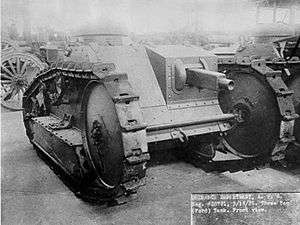Ford 3-Ton M1918
The Ford 3-Ton M1918 was one of the first tank designs by the U.S. It was a small two-man, one-gun tank. It was armed with a M1919 Browning machine gun and could reach a maximum speed of 8 mph. The 3-Ton had a 17-gallon tank that gave it a maximum range of 34 miles.
| Ford 3-Ton | |
|---|---|
 | |
| Type | Tankette |
| Place of origin | United States |
| Specifications | |
| Mass | 3 tons |
| Length | 14 ft (4.3 m) |
| Width | 6 ft (1.8 m) |
| Height | 6 ft (1.8 m) |
| Crew | 2 (Driver and gunner) |
Main armament | .30 calibre (7.62 mm) Browning machine-gun |
Secondary armament | none |
| Engine | Two Ford Model T engines[1] 45 hp (34 kW) |
| Power/weight | 10.4 hp/t |
Operational range | 55 km (34 mi) |
| Maximum speed | 12.8 km/h (8 mph) |
History
Design on the 3-ton tank started in mid-1917, before which American tank forces had been largely equipped with British or French examples. The 3-Ton was a two-man tank designed so that American forces could use another tank besides the Renault FT in battle, and was designed around the FT but as a cheaper alternative. Its two Ford Model T engines were controlled by the driver, seated at the front with a gunner beside him who had control of a .30-06 machine gun (either a M1917 Marlin machine gun or M1919 Browning machine gun) on a limited-traverse mount with approximately 550 rounds of ammunition.
The initial production run of the 3-ton was of fifteen vehicles; one of these was sent to France for testing. A contract for 15,000 of these vehicles was awarded; however, the U.S tank corps felt it did not meet the requirements they wanted. The contract for the 15,000 tanks was ended by the Armistice, leaving only the fifteen original vehicles produced. [2]
The French Army evaluated the Ford 3-Ton tank and thought it inferior to the native Renault FT. However, the 3-Ton Tank was seen to have potential as a cheap, light, all-terrain artillery tractor especially for batteries of the Canon de 75 modèle 1897. One thousand five hundred 3-Ton tanks were ordered from Ford but the Armistice intervened before any were delivered and the order was cancelled.[3]
Survivors
- There are two known survivors; one is at the U.S. Army Armor & Cavalry Collection at Fort Benning, Georgia; the second is with the Ordnance Collection at Fort Lee, Virginia.
See also
References
- Ford M1918 3-ton tank, Historical Firearms, February 24, 2018, retrieved February 26, 2018
- Forty, George; Livesey, Jack (2012). The Complete Guide to Tanks & Armoured Fighting Vehicles. Leicestershire: Arness publishing. p. 81. ISBN 978-1-78019-164-5.
- Vauvillier, François (October–December 2009). "1916-18 des Chenilles pour le 75". Guerre, Blindes & Matériel (in French). 89: 74.
- Hogg, I.V.; Weeks, J. (1980), The Illustrated Encyclopaedia of Military Vehicles
External links
- Ford 3-Ton
- Ford 3-Ton tank(1918)
- "Ford-M1918-WWI-Tank - Vehicles". Fiddlersgreen.net. Retrieved 18 August 2017.
- "Ford Model 1918 3-ton (M1918) Light Tank Combat Vehicle". Militaryfactory.com. Retrieved 18 August 2017.
| Wikimedia Commons has media related to M1918 tank. |